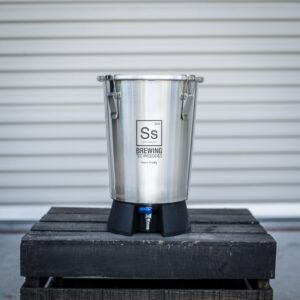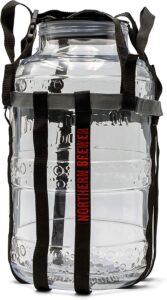Pitch Yeast
Jim Beam Fermenting
3 Gallon Fermenter – perfect for a “wash.”
”Carboy – perfect for a “mash.”
Pitch Yeast
Cool mash down to 80 F (65F is most efficient) … you can add cold water and/or ice to speed cooling the mash if diluting is desired. Cool the mash as quickly as you can. Immerse bags of ice to help cool. By cooling the mash quickly, bacteria, yeast etc. which is all around us can not get started.
Check Specific Gravity Before Pitching
This reading will tell you your expected alcohol after fermentation. Use a refractor. This O.G. (original gravity) must be done at this stage in order to subtract the F.G. (final gravity) after fermentation. This product number gravity will tell you what the ABV is before distillation.
Yeast the Fermenter——————–
There are two main factors in producing aroma and taste. Yeast is one, the other is the main ingredient used, such as wheat, rye, etc.
When buying a desired strain of yeast look for urea free yeast. This adds a cleaner taste but more importantly there is no ethal cabomate produced which is a carcinogen.
Lag Period – Oxygen Needed
Aerobic phase: Oxygen throughout the mash is essential right at the start of fermentation to enable the yeast to multiply, called budding. This is the lag phase of distilling. But a continuous supply of oxygen will produce a vat of nothing but yeast and no alcohol. The yeast uses some of the sugars to reproduce. The reproduction is rapid. Most reproduction is finished 4 to 6 hours and no longer than 12 hours. Reproduction stops at 50 million cells per milliliter. Oxygen is your friend in the first lag period.
Next – No Oxygen Please
Anaerobic phase: Once the oxygen is gone reproduction stops and the production of alcohol begins. When the yeast makes alcohols it does it by anaerobic fermentation. This means an oxygen starved environment. The yeast gives off carbon dioxide in the fermentation process. The mash needs to be enclosed so that no oxygen can get to the liquid. Any oxygen in the mash not used by the yeast will exit when the cabon dioxide exits. Any remaining oxygen in the mix will be carried away by the CO2 bubbles.
Any oxygen introduced after fermentation begins will oxidize and leave a stale taste in the mix — a ruined batch! Oxygen is your enemy after the lag period.
Yeast Stress
When conditions are not ideal for a strain of yeast it becomes stressed, producing foul smelling non-flavorful non-healthy byproducts and even stopping the fermentation before converting all the starches.
Another stress on yeast is alcohol. Yeast dies in a dense alcohol solution. However while they are producing alcohol they develop a tolerance for it up to a point, then they will die or go dormant. An alcohol percentage solution that will normally kill yeast will not kill them when they are producing and developing a tolerance.
Ideal Temp for Yeast
Yeast is sensitive to temperature they live in. In a cold environment the production slows and the yeast will even die if colder than their threshold. Warmer environment than the yeast likes and they produce faster but also produce unwanted oils. Keep yeast close to their desired perfect temperature of 65 deg.
Yeast Death
All the yeast dies off or goes dormant when there are no sugars left to consume. At the end of fermentation the bad or fusil oils are a thin layer on the very top. Ethanol alcohol is floating right under the lighter fusil oils since it also is a light fluid but in a much greater quantity. There is a middle layer where a smaller amount of ethanol is mixing with the mash. The other heavier fluids and materials are on the bottom. The dead yeast is the heaviest of the all the particles and falls to the very bottom when it dies. Yeast has a reproductive cycle where it dies after making 17 to 22 daughter yeast cells. Yeast has a reproductive life and a chronological life.
Pre-Proofing Yeast
Use 4 to 8 oz coffee cup or a mason jar .. to create a starter environment. Yeast “learns” to feed on sugars when it wakes up from that little packet you bought – it takes yeast seven generations to learn how to digest a different kind of sugar, so take your starter liquid from the wash batch. Get this yeast colony started while the mash or wash is cooling down. Let it produce a nice foam to demonstrate it is producing many daughter yeast cells.
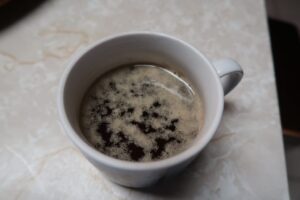
Take initial gravity reading.
Aerate: Oxygen Needs to be Added first, before Yeast Added
Yeast needs oxygen to reproduce and form it’s yeast colony that will convert sugars to alcohol. Oxygen is an essential ingredient right at the start of fermentation to enable the yeast to multiply, called budding. This is the lag phase of fermenting.

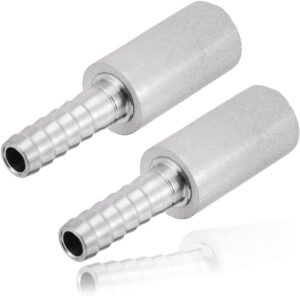
Use a fish bubbler with micro holes in a stone to introduce oxygen throughout the liquid. Move the stone around for 5 to 10 minutes. An alternate method not as efficient, is pouring the liquid several times from one bucket to another in a slow stream with a waterfall like appearance.
Do not blow through a tube into the mash to aerate it. That is carbon dioxide not oxygen! Plus you will be introducing bacteria.
— Checklist —
- 1. Aerate the mash/wash
- 2. Check temperature 85F or less
- 3. Add Yeast Nutrient (not necessary if using a yeast packet that has both yeast and nutrients, or if using grains)
- 4. To get your yeast to be fast acting “Turbo Yeast” – add Diammonium Phosphate nutrient.
- 5. Make sure the PH is 5.2
- 6. Put in the correct amount of Yeast.
1. Yeast Nutrients
Man cannot live by bread alone [Bible verse]. Yeast cannot live by sugar alone. If Yeast doesn’t have nutrients it will not eat the sugars. Nutrients are essential to the yeast doing it’s fermenting in any sugar added fermentation. Divided application is acceptable; half at the start, and half mid fermentation.
If you are using grains or fruits, there are plenty of nutrients in those food materials themselves. There is no need to add nutrients. You can add nutrients if you like but not necessary.
1 to 1.5 teaspoons per gallon of water (as per packet). 4 teaspoons for 3 gallon batch.
2. Turbo – (Diammonium Phosphate, AKA DAP)
Diammonium Phosphate (DAP) is a good source of nitrogen for yeast. The added nitrogen will help the yeast remain very active through the ferment.
Add 1/2 to 3/4 grams per gallon (as written on 1 lb packet) 2 grams or 1/2 teaspoon per 3 gallons batch
Take a temperature reading. The mash should ideally be 74 F to start fermentation … The temperature will rise slightly as fermentation is in process.
3. PH Level – a Must
Check the PH. Don’t be surprised if in a 3 gallon sugar wash you need to put in the juice from several lemons or limes to get a PH of 5.2. Yeast are most productive and don’t produce foul oils at their desired PH of 5.2. Yeast above a PH of 7.2 will become active but other yeasts will start up and compete with your pitched yeast and that means off flavors. At PH 5.2 you create an environment where just your ETOH yeast can thrive.
4. Pitching the Correct Amount of Yeast
Amount
DADY Yeast- add 1 to 2 grams per gallon (per instructions on 1 lb yeast package)
1.5 teaspoon for 3 gallons in the liquid of a wash or mash.
DADY (Distillers Active Dry Yeast) is a specially selected strain of Saccharomyces Cerevisae designed for distillers use in grain mash fermentations for ethanol. DADY will produce maximum alcohol yields under controlled temperatures (less than 90° F/32° C). DADY yeast has been cultured to have a tolerant level up to 18% alcohol.
You should introduce the large pre-pitch starter along with additional yeast needed for the batch. When this is introduced to the main mash or wash it will overwhelm with the production of daughter yeast cells. This rapid population of yeast cells will dominate the batch and exclude any foreign yeast and bacteria that have come from the grains that you have introduced from becoming active.
Over Pitch
If you mistakenly “over-pitch” your yeast- just make sure you have a LOT of copper in the mash to get rid of the extra sulfur compounds when the yeast start eating dead yeast cells to stay alive.
Under Pitch
Under pitching causes a long lag time that can allow a bacterial infection to take hold in the mash. If there is sufficient nutrients the small amount of yeast will take a longer time to make a colony in the initial lag period of fermentation and take two or three times as long to establish the colony. But under–pitching will absolutely work provided there are enough nutrients.
Fermenting Process
Cool the liquid to 30C (86F) a little more than room temperature. Use your temperature gun. The best temperature is stated on the yeast package which is usually 65F to 70F.
Ferment the mash at a constant 25C (77F). One of the by products of fermenting is an abundance of CO2. This gas is released by your airlock. When the airlock stops bubbling the fermentation is over and the yeast has not died, but gone into a dormant state.
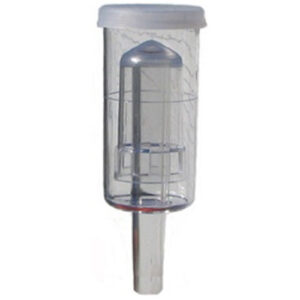
Air Lock
Note: If you bubbler isn’t bubbling then you probably have a leak of the lid. Carbon dioxide is given off by the yeast and is heavier than oxygen so it will protect the mash from any oxygen if there is a small leak.
Anti-Foaming Agents
Anti-Foaming Agents break up the bubbles that lodge at the surface. Fruits, grains, and molasses create big amount of foam and can outgrow the fermenting chamber if there is not enough head room.

Fermenting in Mexico
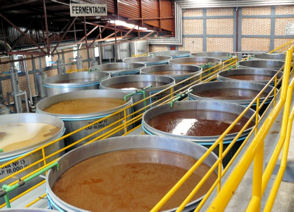

Fermenting Finished
At this point the top of the fermented grain based mash looks like a wart and hence the finished fermented liquid was called a wart!
The air lock has stopped bubbling.
The yeast sediment when it stops producing alcohol is heavy and falls to the bottom. Many People referencing this yeast on the bottom represent that the yeast has died. That bottom thick layer of yeast contains both dead and dormant yeast cells. The dead cells have propagated their limit of daughter cells. The dormant yeast cells have stopped because there is now a low ratio of water because of the now present alcohol. They are waiting for more water. Or the cells have run out of sugars to eat. Or the temperature has gone below 65F deg. or above 95F deg.
How Long does it Take?
If there are little sugars for the yeast to eat the fermentation will be quick. If the mash is loaded with sugars, then the fermentation will take a long time. Fermentation can be somewhere from one week (average time) to two weeks depending on the type of yeast, the batch temperature, the amount of starches to break down.
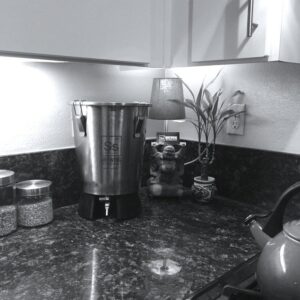
A 3 Gallon Fermenter
Iodine Test
Take tincture iodine and put a drop on a spoon full of the mash liquid. It should dissipate and almost disappear. If the drop turns to a black dot, then there are unfermented sugars.

